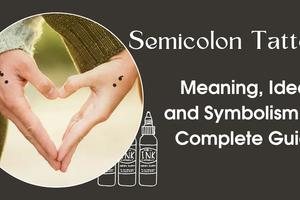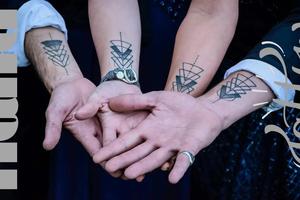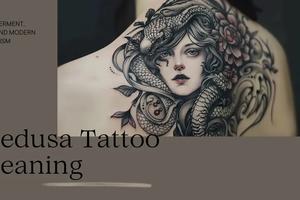American Traditional Tattoos: History, Symbols & Design Ideas

Key Takeaways
Essential insights to remember
Bold and Iconic: American Traditional tattoos are defined by bold outlines, flat vibrant colors, and iconic motifs rooted in naval and patriotic themes.
Deep Symbolism: Each design — from anchors to eagles — carries rich historical and emotional meaning, making your tattoo deeply personal.
Legendary Artists: The style was pioneered by icons like Sailor Jerry, Ed Hardy, and Bert Grimm, whose flash designs still inspire artists today.
Timeless Style: Unlike many modern trends, Old School tattoos age gracefully and maintain their legibility over decades.
Know Before You Ink: Understanding design rules, meanings, and aftercare is key to getting a tattoo you’ll proudly wear for life.
Ink with Legacy: The Timeless Appeal of American Traditional Tattoos
American Traditional tattoos, often referred to as "Old School" ink, are more than just body art — they are cultural artifacts. Characterized by bold black outlines, limited but striking color palettes, and iconic symbols like anchors, roses, daggers, and eagles, these tattoos represent a fusion of heritage, rebellion, and personal expression. What began on the weathered arms of sailors and soldiers has transformed into one of the most enduring and celebrated styles in tattoo history.
While modern styles embrace realism, watercolor effects, and minimalism, American Traditional tattoos remain unapologetically bold and flat, built to last through the decades. Each line etched into the skin tells a story — of survival, identity, heartbreak, or fierce loyalty. The style’s staying power lies in its clarity, confidence, and timeless symbolism, making it a favorite among collectors and first-timers alike.
““🗯️ "These tattoos don’t just make a statement — they carry a legacy."
In the sections that follow, we’ll uncover how this iconic art form emerged, evolved, and why it continues to thrive in today’s diverse tattoo culture. From the salty decks of Navy ships to high-end studios, American Traditional ink is still making waves.

The Origins of American Traditional Tattoos: Sailors, War, and Rebellion
The roots of American Traditional tattoos run deep through the tides of maritime history and the bloodlines of rebellion. While tattooing has existed for thousands of years — as seen in the 5,000-year-old tattoos on the Ötzi Iceman — the Western world was slower to embrace the art form. It wasn’t until the 1700s that European sailors, particularly those sailing with Captain James Cook, encountered the Polynesian and Pacific Island tattooing cultures and brought the practice back home. These early adopters began inking their bodies as mementos of exotic lands, naval exploits, and personal transformations.
As seafarers roamed from port to port, they collected not just stamps in a passport but emblems on their skin. These tattoos served as identifiers, talismans, and expressions of grit. The imagery was practical and symbolic: anchors for stability, swallows for safe return, ships for freedom. Tattoos also became an unspoken badge of camaraderie among men who lived — and often died — by the ocean.
During the 20th century, especially between World War I and World War II, tattoos transitioned from sailor folklore into a broader countercultural statement. Enlisted men in the U.S. military marked their bodies to show unit pride, battlefield experience, or emotional tributes like “Mom” and sweetheart hearts. This wartime era helped standardize and spread the American Traditional style, especially through tattoo shops stationed in naval hubs like Honolulu, where legendary artists like Norman “Sailor Jerry” Collins left their indelible mark.
““🧭 "Tattoos were the visual diary of a generation that had no guarantees of coming home."
From the circus tent to the battlefield to the prison yard, American Traditional tattoos became the skin-deep symbols of those who lived outside conventional society. They weren’t just rebels — they were storytellers, survivors, and pioneers of a gritty new art form.

Icons Who Shaped the Tradition: Legendary Artists
Behind every iconic tattoo style stands a cadre of pioneers who laid the foundation — line by line, needle by needle. American Traditional tattooing owes much of its legacy to a handful of visionary artists whose bold techniques and distinct styles defined an era and continue to inspire generations.
🧔 Norman "Sailor Jerry" Collins (1911–1973)
Arguably the most recognized figure in American Traditional tattooing, Sailor Jerry fused Western motifs with Japanese influences he encountered during his Navy service. From his Honolulu-based shop, he popularized flash art sheets filled with eagles, ships, pin-up girls, and fierce panthers. Jerry also revolutionized the field technically — introducing sterile practices, custom ink blends (including purple!), and superior machine configurations.
⚓ Amund Dietzel (1890–1974)
Known as the “Master in Milwaukee,” this Norwegian-born sailor-turned-artist was one of the earliest adopters of the American Traditional style. His robust catalog of flash designs, inspired by his own maritime life, made him a household name among early 20th-century tattoo clients.
🎨 Don Ed Hardy (b. 1945)
While Ed Hardy is known for blending Japanese and Western tattooing, his early career was steeped in the American Traditional lineage. A student of Sailor Jerry, Hardy helped elevate tattooing into a respected art form and was pivotal in bridging the gap between old-school grit and high-art elegance.
🧵 Bert Grimm & Bob Shaw
Bert Grimm ran what is believed to be America’s longest-operating tattoo parlor in Long Beach, California — a sailor’s rite of passage. Bob Shaw, his protégé and later the president of the National Tattoo Association, helped preserve and promote the American Traditional aesthetic well into the late 20th century.
✒️ Samuel Steward (aka Philip Sparrow)
An intellectual and professor turned tattoo artist, Steward chronicled much of mid-century tattoo culture in his memoir Bad Boys and Tough Tattoos. His work remains essential reading for serious apprentices and cultural historians alike.
““💡 Note: Many of today’s flash designs are direct descendants of these artists’ original sheets. Their influence isn’t just historical — it’s alive in almost every eagle, anchor, or dagger etched today.
These legendary names didn’t just tattoo skin — they shaped a movement. Their dedication, innovation, and artistry transformed tattooing from a back-alley rebellion into a respected and codified cultural practice.

Defining Characteristics of American Traditional Tattoos
American Traditional tattoos are instantly recognizable — and that’s no accident. They’re built on strict design principles that prioritize durability, visibility, and symbolic clarity. These foundational traits aren't just stylistic preferences — they are time-tested rules that help the tattoo remain readable and impactful for decades, even as the skin ages and stretches.
✒️ Hallmark Features of the Style:
- Bold, Black Outlines
Every design starts with thick, black lines. These outlines ensure the tattoo won’t blur over time and provide a strong visual framework for the color to sit within.

- Limited Color Palette
Traditional tattoos rely on solid, saturated blocks of color — primarily red, green, yellow, blue, and of course, black. The pigments were originally chosen for their availability and longevity in skin.

- Flat Design (2D Look)
Unlike realism or watercolor tattoos, American Traditional pieces are intentionally flat. There’s minimal shading or depth — the focus is clarity, not illusion.

- Simplified Imagery with Symbolic Power
Whether it’s a heart, dagger, or panther, each image is stripped to its most powerful essence. These designs are more like visual metaphors than decorative artwork.

- Minimal Detail, Maximum Impact
Traditional tattoos rarely feature intricate linework or micro-shading. Instead, they use visual economy to get their point across with maximum punch.

““"Every line is a commitment. Every color choice, a statement."
““🎯 Pro Tip: These characteristics are especially ideal for those seeking a timeless look that won’t fade into ambiguity as years pass.
American Traditional tattoos may appear simple at first glance, but their strength lies in their deliberate constraint — every line and color is chosen with purpose. This is what makes the style not just art, but enduring iconography.
Most Popular Motifs and Their Symbolism
In American Traditional tattooing, every symbol carries a story — a shorthand visual for loyalty, bravery, heartbreak, or protection. These designs were never random; they were purposeful emblems, especially for those navigating life’s storms — both literal and metaphorical. Let’s explore some of the most iconic motifs that continue to define this style.
🦅 Patriotic & Military Icons
- Eagle: A quintessential American symbol, the eagle represents freedom, strength, and fierce independence.
- American Flag: Inked by soldiers and patriots alike, the flag embodies loyalty to country and personal sacrifice.
- Stars: Often seen as nautical stars or military insignia, representing guidance, direction, and protection.

““"For many service members, tattoos were a uniform you never took off."
⚓ Nautical Themes
Deeply rooted in seafaring tradition, these motifs are both practical and spiritual.
- Anchor: Stability, grounding, and hope — often dedicated to loved ones left onshore.
- Swallow: A symbol of return; sailors tattooed swallows after traveling 5,000 nautical miles.
- Ship: Adventure, freedom, and the unpredictable nature of life.
- Lighthouse: Guidance in the darkest times.

💘 Love & Loss
These timeless icons reflect vulnerability, romance, grief, and remembrance.
- Heart (with or without banner): Love, passion, or memory of someone dear — often adorned with names or "Mom."
- Rose: Beauty, affection, and resilience. Can also represent lost love or remembrance.
- Crying Heart / Heart with Dagger: Betrayal, sorrow, and the strength to overcome heartbreak.

🐍 Protection & Power
Symbolic of strength, defense, and confrontation with danger.
- Panther: Ferocity, power, and protection — often used in cover-ups due to its bold design.
- Dagger: Duality of pain and courage; when combined with a rose, it represents love and loss intertwined.
- Snake: Rebirth, cunning, and warning — often coiled and ready to strike.

🐟 Myth & Nature
These animals embody deeper meanings drawn from nature, spirituality, and cultural beliefs.
- Butterfly: Transformation, freedom, and spiritual growth.
- Shark: Fearlessness and survival; a totem of constant motion and protection at sea.
- Owl: Wisdom, mystery, and night vision — popular with introspective individuals.
- Wolf: Loyalty, leadership, and family strength.
- Gypsy Woman: Feminine power, freedom, and spiritual mysticism.
These motifs aren’t just timeless — they’re deeply personal. Many are still found on flash sheets around the world, reaffirming their universal appeal across generations of ink lovers.
Flash Tattoos: Old School Designs with New-Age Demand
Walk into any authentic tattoo parlor, and you’ll likely be greeted by walls filled with “flash” — sheets of pre-drawn designs ready to be chosen, inked, and immortalized. Flash tattoos are one of the defining rituals of American Traditional culture. They blend spontaneity with heritage and are often the very first exposure people have to the tattoo world.

🎨 What Is Flash?
Flash refers to a collection of standardized tattoo designs, traditionally hand-painted by the artist on sheets of paper or canvas. These designs are meant to be repeated — unlike custom tattoos, which are designed only once for a specific client.
““"Flash is the visual menu of classic tattooing — it speaks for itself, no explanation needed."
Classic American Traditional flash sheets feature:
- Anchors, daggers, swallows, roses, skulls, and eagles
- Simple, bold compositions
- Heavy outlines with solid color blocks
- Iconic banners reading “MOM,” “LOVE,” “DEATH BEFORE DISHONOR”
🧑🎨 Flash as Artistic Expression
Far from being generic, flash represents an artist’s signature style and preferences. Tattoo legends like Bert Grimm, Sailor Jerry, and George Burchett created legendary flash sheets that are still used and replicated today.
Many studios also host Flash Days — events where customers pick from artist-designed flash sheets, often at reduced prices, with proceeds going to charity. These events keep the tradition alive and accessible.
✏️ Modern Flash Use Cases
- Walk-ins: Ideal for spontaneous tattoo decisions
- Practice: Beginner artists use flash to develop consistency
- Tradition: Veterans and purists favor flash for its authenticity
- Merchandise: Flash-inspired art now appears on prints, apparel, and décor
Flash isn’t just a nostalgic throwback — it’s a living, breathing expression of the American Traditional ethos. Whether you’re picking a design off the wall or drawing inspiration for your own, flash connects you directly to tattoo history.
Designing a Traditional Sleeve: Patchwork with Personality
In the world of American Traditional tattoos, sleeves aren’t just about coverage — they’re about character. Unlike Japanese-style sleeves that flow as one interconnected narrative, Traditional sleeves embrace a “patchwork” philosophy: individual, self-contained designs scattered across the arm, harmonized through spacing, balance, and shared aesthetics.
““🎨 Think of it like a quilt — stitched together from powerful, personal pieces.
🧵 What Defines a Patchwork Sleeve?
- Individual Motifs: Each tattoo — whether a panther, rose, dagger, or anchor — stands on its own with a complete design.
- Deliberate Gaps: Empty skin spaces (called “negative space”) between the pieces help each one pop visually.
- Cohesive Style Rules: All tattoos follow Traditional conventions: thick outlines, flat colors, and classic iconography.
📐 Building a Traditional Sleeve – Key Principles
- Start with a Statement Piece
Begin with a bold anchor design — such as an eagle or a ship — on a visible area like the upper arm or forearm. - Add Supporting Motifs
Fill around the central piece with related elements: roses, hearts, daggers, or bannered names. - Mind the Flow, Not the Connection
Unlike fluid Japanese tattoos, the focus here is spacing and rhythm. A good sleeve feels balanced — not crowded or empty. - Use “Filler” Wisely
Need to fill tight gaps later? Common Traditional fillers include stars, spiderwebs, small roses, dice, or lightning bolts.
✍️ Artist Tip:
““💬 “Don’t try to plan every inch in one sitting. Traditional sleeves are meant to evolve over time — just like the people wearing them.”
The patchwork sleeve is the ultimate expression of storytelling through skin — each symbol a badge of memory, meaning, or mood. And when done right, it looks effortlessly cohesive and unapologetically bold.
American Traditional vs Neo-Traditional: Know the Difference
Though they share a common lineage, American Traditional and Neo-Traditional tattoos are distinctly different in both aesthetic and philosophy. If American Traditional is the bold grandparent rooted in simplicity, Neo-Traditional is the expressive descendant — more ornamental, detailed, and diverse in design.
““🔍 "Old School tattoos are blunt and iconic. Neo-Traditional adds layers, flourish, and flair."

🖋️ Side-by-Side Breakdown
Below is a visual comparison of both styles to help clarify their defining traits:
📷 Visual Aesthetic Differences
- American Traditional:
Looks like a vintage poster or military badge — bold, flat, and instantly readable. Often features banners, pin-up girls, and maritime themes. - Neo-Traditional:
Adds complexity — think flowing hair, detailed animals, jewelry, glowing eyes. It draws from Art Nouveau and fantasy art.
While both styles have artistic merit, your decision should reflect your personal taste, the message you want to convey, and the visual impact you want to maintain over time. Many collectors even combine both across different parts of the body.
Should You Choose an American Traditional Tattoo?
Choosing a tattoo isn’t just about art — it’s about identity. American Traditional tattoos carry more than bold lines and vivid color; they come with attitude, symbolism, and a deeply embedded cultural history. So how do you know if this classic style is right for you?
““💡 Ask not just what the tattoo looks like — ask what it says about you.

✅ Ideal Candidates for American Traditional Ink:
- Lovers of Bold, Timeless Art
If you prefer strong lines over delicate detail and want your ink to look sharp even after 20+ years, this style delivers with no apologies. - Minimalists Who Want Maximum Impact
You don’t need realism or ornate detail to say something meaningful. A single rose, snake, or eagle in Traditional style can be louder than a full-sleeve photo-realistic portrait. - Sentimental Storytellers
Whether it’s an anchor for your father, a panther for strength, or a heart that carries your grief, every motif can carry deep personal resonance. - Collectors Who Value Heritage
If you’re building a body of work with historical grounding — one that pays homage to classic American tattoo culture — this is the gold standard.
🚫 When It Might Not Be a Fit:
- You’re looking for hyperrealism, watercolor effects, or ultra-fine linework
- You want soft, pastel color gradients or very delicate symbols
- You’re expecting a single flowing, detailed sleeve (in which case, Japanese or Neo-Traditional may be better)
🎯 Placement Tips for Maximum Impact
- Forearm/Upper Arm: Perfect canvas for anchors, hearts, or eagles — high visibility and great longevity
- Calves/Thighs: Ideal for bold motifs like tigers, ships, or gypsy heads
- Chest/Back: Space for larger motifs or flash compositions with symmetrical balance
- Hands/Neck: Best left for experienced collectors due to fading risk and social perception
““🗯️ “American Traditional tattoos age with dignity — just like the stories they represent.”
So if you want a tattoo style that’s loud, proud, and built to last — both visually and culturally — then American Traditional may just be the perfect choice to wear your story.

Conclusion: Carrying History on Your Skin
American Traditional tattoos aren’t just ink — they’re inheritance. They carry the weight of sailor lore, wartime brotherhood, outlaw rebellion, and a deep respect for artistic discipline. With each bold line and saturated hue, you're wearing a design that once marked survival, loyalty, and unfiltered emotion.
In an age of digital art and fleeting trends, American Traditional remains unapologetically analog. Its motifs — anchors, panthers, roses, and eagles — are less about fashion and more about foundation. Whether you’re starting your tattoo journey or adding to a decades-old sleeve, this style anchors you to something real: an art form born from grit, heart, and heritage.
““🔥 "Trends fade. Tradition lasts."
If you’re drawn to tattoos that age gracefully, resonate deeply, and demand respect the moment they’re seen — then American Traditional is more than a style. It’s a legacy waiting to be lived in.





